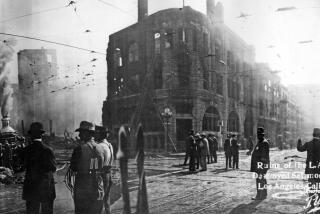Papers Publish Unabomber’s Manuscript
- Share via
SAN FRANCISCO — Giving in to the elusive Unabomber, the Washington Post and the New York Times agreed Monday to publish the deadly terrorist’s 35,000-word manuscript in today’s editions of the Post at the request of the nation’s top law enforcement officials.
Despite concerns that printing the manifesto might set a precedent for other would-be terrorists, the publishers acted just before a deadline set by the Unabomber, who had pledged not to kill again if one of the newspapers published his treatise in full.
The newspapers’ decision, made at the request of Atty. Gen. Janet Reno and FBI Director Louis J. Freeh, was praised by investigators who hoped it would bring new leads in the cases, but was criticized by some who said the papers should not give in to terrorists.
“For three months the Washington Post and the New York Times have jointly faced the demand of a person known as the Unabomber that we publish a manuscript of about 35,000 words,” said Post Publisher Donald E. Graham and Times Publisher Arthur O. Sulzberger Jr. in an unusual joint statement. “If we failed to do so, the author of this document threatened to send a bomb to an unspecified destination ‘with intent to kill.’
“From the beginning, the two newspapers have consulted closely on the issue of whether to publish under the threat of violence. We have also consulted law enforcement officials. Both the Attorney General and the director of the Federal Bureau of Investigation have now recommended that we print this document for public safety reasons, and we have agreed to do so.
“Therefore, copies of the Unabomber’s unaltered manuscript are being distributed in Tuesday’s Washington Post. The decision to print was made jointly by the two newspapers, and we will split the costs of publishing. It is being printed in the Post, which has the mechanical ability to distribute a separate section in all copies of its daily paper.”
Asked whether the publishing of the manifesto would encourage other potential terrorists to demand space or air time from the media, Graham said: “We think this is a singular case but that is one of the things that we asked the FBI to think about because they would have more perspective on this matter.” Graham said the recommendations to print the manifesto came last week and “we agreed with it.”
Graham said the document would be published in all 850,000 copies of today’s Post. Publication of the eight-page special section cost an estimated $30,000 to $40,000.
FBI officials heading the investigation are scheduled to hold a press conference in San Francisco today to discuss publication of the document and the status of the investigation.
Over the past 17 years, the Unabomber is believed to have mailed or placed 16 bombs responsible for killing three people and injuring 23 others across the country.
“It’s awfully hard to put too much faith in the words of someone with the record of violence that the Unabomber has,” Sulzberger told the Post. But, he said: “You print it and he doesn’t kill anyone else; that’s a pretty good deal. You print it and he continues to kill people, what have you lost? The cost of newsprint?”
In an interview Monday night, Sulzberger stressed that the publishers made their own decision to publish the document.
“The government at no point ordered us to print or not to print it,” he said. “The decision was made voluntarily by Don and by me. We did so after consulting with the FBI and others, but at no point was it a demand and that is why it is not a 1st Amendment issue.”
In his writings, the Unabomber has claimed to be an anarchist group called the “Freedom Club” that is seeking to spark a revolution against America’s “industrial-technological system.”
The Unabomber argues in his manifesto that industrial and technological progress have been a “disaster” for the human race. “They have destabilized society, have made life unfulfilling, have subjected human beings to indignities, have led to widespread psychological suffering . . . have inflicted severe damage on the natural world,” he writes.
Technological advances have robbed humans of their self-esteem and stifled the individual. The only alternative, he reasons, is a revolution against technology.
“The technophiles are taking us all on an utterly reckless ride into the unknown,” he writes. “Until the industrial system has been thoroughly wrecked, the destruction of the system must be the revolutionaries’ only goal.”
Reactions to the decision ranged dramatically from those who applauded the move to those who condemned it as foolish, even hazardous.
Sacramento Police Lt. Joe Enloe, who has led his city’s investigation of the April murder of timber lobbyist Gilbert Murray, said the newspapers should be commended for publishing it and predicted it might turn up new leads.
“I’ve always said, the more eyes we get on his writing--on his vocabulary, his use of language and style--the better,” Enloe said. “Someone may recognize something and that may be the tip we need. I don’t think we lose anything by publishing it.”
But Reid Meloy, a forensic psychologist who has closely tracked the Unabomber case, called the newspapers’ decision “a gross mistake” and “absolute foolishness.” He said the editors were “attempting to be rational with an irrational force” and predicted it would have no effect on halting the bombings.
The Unabomber is “a legend in his own mind,” and by publishing, the newspapers are “translating his fantasy into a living reality,” said Meloy, author of “The Psychopathic Mind.”
“He has manipulated the papers,” he added. “He has deceived them into feeling some responsibility for his future behavior.”
Terrorism experts could not predict what effect publication would have on the Unabomber’s conduct, though they expressed hope that it might curtail his murderous bombings, at least temporarily.
“If this will help persuade him not to carry out further acts of violence, then spilling ink is better than spilling blood,” said Brian M. Jenkins, deputy chairman of Kroll Associates in Los Angeles. “Is he going to keep his promise? He might.”
Some media experts suggested that the decision may encourage others to ask for space and time in the media. “It strikes me they have allowed themselves willingly to be held hostage by a terrorist,” said Everette Dennis, executive director of the Freedom Forum Media Studies Center at Columbia University. “It opens the door to similar requests to the networks, to CNN, to others.”
But he suggested that the papers may have more information about the Unabomber than they are printing at this stage. “If this becomes a major element of a sting operation and he’s caught, then they look good,” said Dennis. “But then they may be engaging in subterfuge.”
Robert Blackmore, a retired professor of journalism at Colgate University, expressed dismay and shock at the newspapers’ decision.
“I’m really startled that they’ve done it,” Blackmore said. “There is no honorable way to negotiate with villains, in my mind. I’m not a draw-a-line-in-the-sand kind of person, but this is giving in to blackmail and we have no guarantee that he won’t just escalate his demands.”
Blackmore speculated that the Times and Post felt pressured by the potential that refusing to publish would subject them to attacks if another life was lost to the Unabomber.
“If they had held out, I don’t think anybody would have been critical in the event of a death,” Blackmore said. “People understand the dangers of giving in to blackmail.”
Jeffrey D. Simon, editor of a journal that tracks terrorism, said that publishing the manifesto was “worth a try,” but acknowledged that the decision was a difficult one--with no guarantee of success.
“What separates terrorism from all other conflicts is that there are no doctrines you can apply that assure you of victory,” said Simon, who edits the Los Angeles-based TVI Report. “There are no armies you can send in to guarantee that you will defeat the enemy. So while it sounds good on paper to have a policy of no concessions, in reality you have to be flexible.”
Despite the Unabomber’s claim to be a group, the FBI is certain the bomber is an individual. The agency gave him the code name “UNABOM” because his early targets were university campuses and airlines.
But in recent years, his targets have become more varied and his handcrafted bombs more sophisticated, compact and deadly.
In April, a bomb he sent to the Sacramento offices of the California Forestry Assn. killed Murray, the group’s president. In December, a mail bomb killed advertising executive Thomas Mosser at his New Jersey home.
In June, shortly after the bombing of the Oklahoma City federal building, the Unabomber changed tactics and threatened in a letter to the San Francisco Chronicle to blow up a plane at Los Angeles International Airport.
The next day, a separate letter received by the New York Times said his threat was a hoax, but airport officials maintained high security at LAX throughout the busy July 4 weekend.
Having captured the nation’s attention, the terrorist pledged to stop killing if the New York Times or Washington Post would publish his lengthy treatise on the ills of America’s technological society.
The Unabomber set a 90-day deadline for the papers to publish the manifesto. The deadline would have run out Sunday.
But the papers are not entirely off the hook. The Unabomber reserved the right to continue “non-lethal sabotage” if one of the papers did not publish three 3,000-word sequels during the next three years.
For the past three months, an 80-member FBI task force headquartered in San Francisco has pursued thousands of leads with no apparent success.
Agents have combed junkyards in the Bay Area to see if the terrorist might have shopped there for essential bomb materials. They searched for a man captured on video who quickly left the scene of the Sacramento bombing when he realized he was being filmed.
The FBI sent the manuscript to dozens of professors to see if anyone recognized his style or thought process. Agents talked to leftists and anarchists from Berkeley to Oregon.
They combed college rosters for students who matched the time frame of the Unabomber’s known movements from Chicago to Utah to the Bay Area.
But despite their efforts--and more than 20,000 tips from the public--FBI officials say they do not have a single good suspect in the bombings.
While publication of the document may placate the Unabomber, some have argued it is likely to have little effect on the public.
Author Kirkpatrick Sale, writing in the Nation, panned the manuscript, calling it “a woodenly written term paper, full of academic jargon and pop psychology, repetitive and ill-argued, that will keep only the most dedicated readers awake beyond its opening paragraphs.”
Paddock reported from San Francisco, Warren from Sacramento and Randolph from Los Angeles. Times researchers Paul Singleton in Los Angeles and John Beckham in Chicago contributed to this story.
More to Read
Sign up for Essential California
The most important California stories and recommendations in your inbox every morning.
You may occasionally receive promotional content from the Los Angeles Times.










